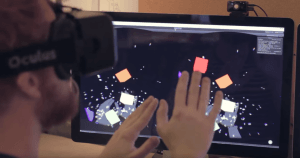ChromaChord: A Virtual Musical Instrument
IDIA Lab: Ball State University
ChromaChord utilizes a combination of the Oculus Rift headset and an attached Leap Motion controller to create an immersive 3D VMI environment. The Oculus Rift provides a three-paneled visual interface, through Unity, that allows the users to access different component windows of the instrument (simply by turning their head), while the Leap Motion Controller allows the user to interact with the visual interface to musical effect (processed and generated in Max/MSP).
ChromaChord uses the Oculus Rift DK2, a virtual reality headset to immerse the performer within the VMI. Utilizing two cameras in the virtual environment, this device relays a stereoscopic image to the wearer allowing for highly dimensional experiences. Additionally, a gyroscope, accelerometer, and magnetometer detect real-world head rotation and transform its virtual equivalents. Additionally, a peripheral infrared camera captures limited-range positional tracking.
Mounted to the Oculus Rift is affixed a Leap Motion. This provides infrared tracking of hands. In our application, the Motion tracks the user’s real world hands and simulates them, mimicking hand positions and finger movements. Therefore, the user’s own hands are the primary input mechanism.
Custom Software
- Key note triggering and glow by Leap Motion hand touches
- Particle generation triggered Leap Motion hand touches
- Button click and glow by Leap Motion hand touches
- Particle destruction and orbit physics
- OSC Server and Client configurator / Message Handler / Data Handler
Our graphical user interface is composed of three sections – left, center and right panels. On the left, the user can see the modulation sphere. By touching this sphere, the user generates orbital particles. The number of these particles affects a live process on the notes. The user can remove these particles by simply swiping them away. Turning to the right reveals the root note and scale type controls. To select a root note and scale type, the user must press the desired button. The interface responds by highlighting the selected options.
The center module contains the keys, a chromatic scale in two colored columns based on the Solfège. This is the core performance area of the UI. In addition there are arrows facing up and down that the user can touch to raise or lower the octave. All buttons and keys respond to touches by glowing white.
The default window is the center palette, where the instrument itself is located. Within this window, there are two columns of colored keys (four per column) to the left and the right of the screen. To create sound, the user has but to put their hands vertically in front of them and ‘touch’ the keys, which are placed for both ease of use and the ability to contact multiple notes simultaneously to create chords. The notes, themselves, are stacked in intervals of a third from each other; consequently, neighboring notes on the same hand will create conventional harmonies. Between the columns, on the top and bottom-most extremities of them, are two arrows that, if touched, move the current note set up or down an octave. By touching the notes, Unity sends a UDP message to Max/MSP, indicating which note has been touched and remains active until contact has ceased. Similarly, by touching the octave buttons, UDP messages are sent to Max to reassign the MIDI note values. Within Max, MIDI values are then converted to their equivalent frequencies and assigned to their respective oscillators before being processed and output through Max’s audio out.
When looking to the right, the user accesses the settings window, where note assignment takes place. First, the user selects the root note of the scale they wish to be within. The second parameter allows the user to select what mode of scale they would like – the options being: major, natural minor, and harmonic minor. By default, the instrument opens with a root note of C and is in the major mode. The UDP messages sent from the settings window control a series of gates within Max that then send adjusted MIDI values to the instrument’s oscillators.
The performer accesses the modulation window to the left, which controls the frequency and Q of a filter, as well as level of effect. By touching the button in the center, Unity spawns floating particles that surround the user’s hands. The longer the users touches the button, the more particles accumulate; they can be removed by making shaking or throwing motions. Without particles, the filter’s frequency setting is at it’s lowest audible setting, creating a much darker, mellow timbre; alternatively, as more particles accumulate, the filter opens up, allowing for higher frequencies to pass through, creating a brighter, richer timbre. Additionally, the particles move the dry/wet ratio for effects towards the ‘wet’ end of the spectrum, deepening the audibility of the effects. The UDP message sent from the modulation window sends a single numeric value for the total number of particles active; this value is then scaled in Max/MSP to most appropriately suit each parameter that’s being altered.
| Data | 0 | 0 | 0 | 0 | 0 | 0 | 0 | 0 | 0 | 0 | 0 | 0 | 0 |
| Name | Do | Re | Mi | Fa | Sol | La | Ti | Do | Up Octave | Down Octave | Modulation | Root Note | Scale Type |
| Type | Key | Key | Key | Key | Key | Key | Key | Key | Octave Switcher | Octave Switcher | Modulation | Root Note | Scale Type |
| Range | 0-1 | 0-1 | 0-1 | 0-1 | 0-1 | 0-1 | 0-1 | 0-1 | 0-1 | 0-1 | 0-100 | 0-11 | 0-2 |
| Notes | Bottom of octave | Top of octave | 1 when clicked | 1 when clicked | # of particles |
